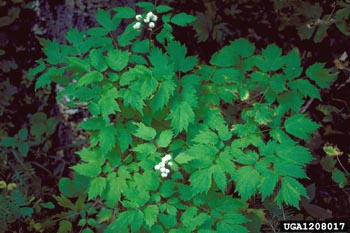Baneberry

Common Name(s):
Baneberry
Red Baneberry
Western Baneberry
Cohosh
Red Cohosh
Necklaceweed
Snakeberry
Scientific Name:
Actaea rubra (Ait.) Willd.
Scientific Name Synonyms:
None Known
Symbol:
ACRU2
Description:
Life Span: Perennial
Origin: Native
Growth Characteristics: A perennial, deciduous herb, usually from 1 to 3 feet tall with one to several branched stems. New shoots arise from a caudex just under the soil surface. Flowering begin in May and ends by late June.
Flowers: Small whit petals, showy stamens, and a rose-like fragrance. Flowers are borne in a terminal or axillary raceme and pollinated by a variety of insects. These flowers can be self-fertile.
Fruits/Seeds: Fruit set is normally close to 100 percent. The fruits are showy, poisonous, red or occasionally white berries. Each berry contains 9 to 16 red-brown, sector-shaped seeds 0.1 to 1.5 inches long.
Leaves: Leaves are large, with two groups of three leaflets.
Stems: One to several branched stems.
Ecological Adaptions:
Baneberry is found in moist forests, and its presence is an indicator of moist soils. Baneberry’s name comes from a poisonous essential oil or glycoside found in all parts of the plant, but most concentrated in the berries and root. In Utah, baneberry can be found in mountain brush, willow-birch, aspen, Douglas-fir, limber pine, subalpine fire, and Engelmann spruce communities, at elevations from 4,500 to 10,000 feet.
Soils: Grows best on cool, moist, nutrient-rich sites. Growth is fair to good on sandy loam, loam and clay loam soils and poor to fairy on gravel, sand, clay, and dense clay. Its growth is best on organic and acidic soils that are at least 20 inches deep and poor on saline or sodic soils.
Uses and Management:
Symptoms of poisoning by baneberry include gastroenteritis, stomach cramps, headache, dizziness, vomiting, diarrhea and circulatory failure.

